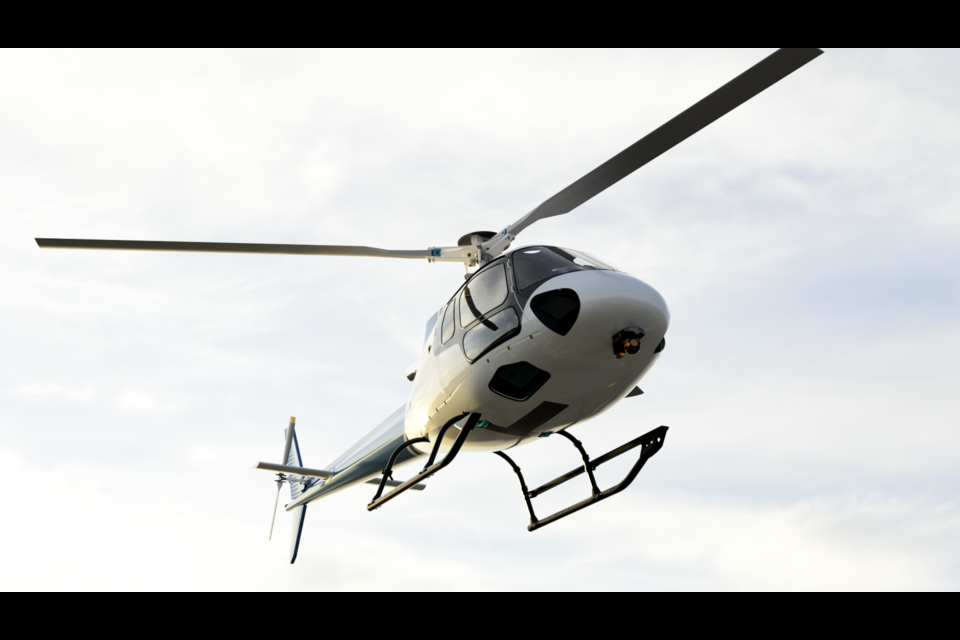B.C. tech companies specializing in wildfire mitigation are diversifying their trading partners amid economic uncertainty with the U.S.
“We’ve always had a vision of a global scale,” said Voxelis Canada Corp. CEO Colin O’Neill. “But we've prioritized discussions with some EU-based partners, as well as Australia.”
The Vancouver-based company manufactures VoxVision, a device covered with cameras and backed by an AI software platform that is attached to firefighting helicopters. The bowling ball-sized device helps pilots navigate through wildfires through thermal scanning and mapping.
Since the implementation of U.S. tariffs on Canadian goods, the cost of raw materials Voxelis uses for manufacturing have gone up, but not to the point of impeding operation plans, O’Neill said. Voxelis is currently adjusting for higher costs from certain vendors, especially American ones, he said.
Voxelis does most of its manufacturing locally, said O’Neill, but the uncertainty of exporting expensive pieces of equipment like the VoxVision to the U.S. has shifted their trading priorities to other international markets.
There have been more than 1,680 wildfires across B.C. since April of 2024, resulting in an estimated 1.08 million hectares of burned land, according to a B.C. wildfire season summary from the province.
Wildfires last season resulted in 51 evacuation orders and 112 alerts, affecting more 16,600 properties across the province, said the report. As of November of 2024, the estimated cost of wildfire suppression in B.C. for the season was $621 million.
NorthX Climate Tech, formerly known as the B.C. Centre for Innovation and Clean Energy, announced in November it would invest $700,00 in Voxelis through its Call for Wildfire Tech initiative. O’Neill said in a statement at the time that the funding would help develop and deploy his company’s AI technology.
Voxelis’ gimbal system streams data to an iPad that is plugged into a local area network installed in the helicopter, which runs the VoxVision iOS app. The data can also be retrieved and viewed from the ground via a web portal, said O’Neill.
VoxVision also autonomously collects environmental and atmospheric data, which helps to predict how the wildfire will act, he said.
Meanwhile, economic uncertainties have also affected B.C. drone company FireSwarm Solutions Inc.
CEO Alex Deslauriers said prior to the second Trump administration, his Squamish-based firm was on the verge of signing several importation and pilot project contracts with U.S. companies for their drones and software.
“There has been an operational pause by these U.S. companies,” he said, adding these companies have delayed decisions in part because FireSwarm imports their drones from Europe.
The company has developed an AI algorithm for data processing and retrofits heavy-lifting drones with sensors and cameras for firefighting capabilities.
The Thunder Wasp quadcopter, built by the Swedish company ACC Innovation AB, can be transported on the back of a pickup truck, and can autonomously collect water and dump it at a nearby wildfire. It can lift 400 kilograms and run for two hours, said Deslauriers.
However, economic uncertainty has pushed FireSwarm to change its trading priorities and eye other markets, he said.
Canada was previously the main priority, followed by the U.S. and then Australia—largely because Australia's peak wildfire season occurs during the North American winter, said Deslauriers.
“What the constraints with tariffs have done is flipped the go-to market strategy to Canada first, Australia second and U.S. third,” he said.
NorthX invested $500,000 into FireSwarm in November. Deslauriers said in a statement at the time that funding would accelerate the development of the drones.
FireSwarm’s first pilot customer is 3 Points in Space Media Ltd., an Ontario-based company that specializes in testing and training remote-piloted aircraft.
Deslauriers estimated the first drone will be ready in September, and said that 3 Points is going through the process of a special flight operation certificate from Transport Canada to operate drones in wildfire controlled airspace.
He said a second drone will be delivered in late 2025 or early 2026 to Campbell River-based Strategic Natural Resource Group, a resource consulting firm.
Deslauriers said his company is also pursuing pilot projects with BC Wildfire Service and Alberta Wildfire to help customers tackle wildfires in 2026.
Voxelis CEO O’Neill said his firm also plans to have multiple units deployed for this year’s fire season to work with the BC Wildfire Service and Alberta Wildfire, and also has an international pilot customer lined up for the southern hemisphere’s fire season.
Firefighting drones and other aircraft to remain separate, for now
Helicopters are one of the most effective tools in firefighting, but also one of the costliest, said O’Neill. It’s challenging to collect environmental and behavioural data from a wildfire, as only fire-suppression aircraft are allowed to operate within about an eight-kilometre perimeter, he said.
The VoxVision device can piggyback on aircraft already fighting fires. Even if the pilot is busy, the gimbal still logs temperature, pressure and smoke data automatically without pilot input, according to O’Neill.
“Drones are not allowed to mix in,” he said. “If a drone takes off on a fire, all the aircraft have to land. … It's not safe to mix the two, yet, and it probably won't be for a while.”
While Deslauriers acknowledged drones and aircraft can’t mix, he said FireSwarm’s access to market will be in nighttime fire suppression, when the airspace won’t be conflicted.
“As we prove our concept in deconflicted airspace, we will then be able to start addressing airspace that is conflicted with other aircraft flying in the vicinity,” he said. “That will require a lot of time.”


